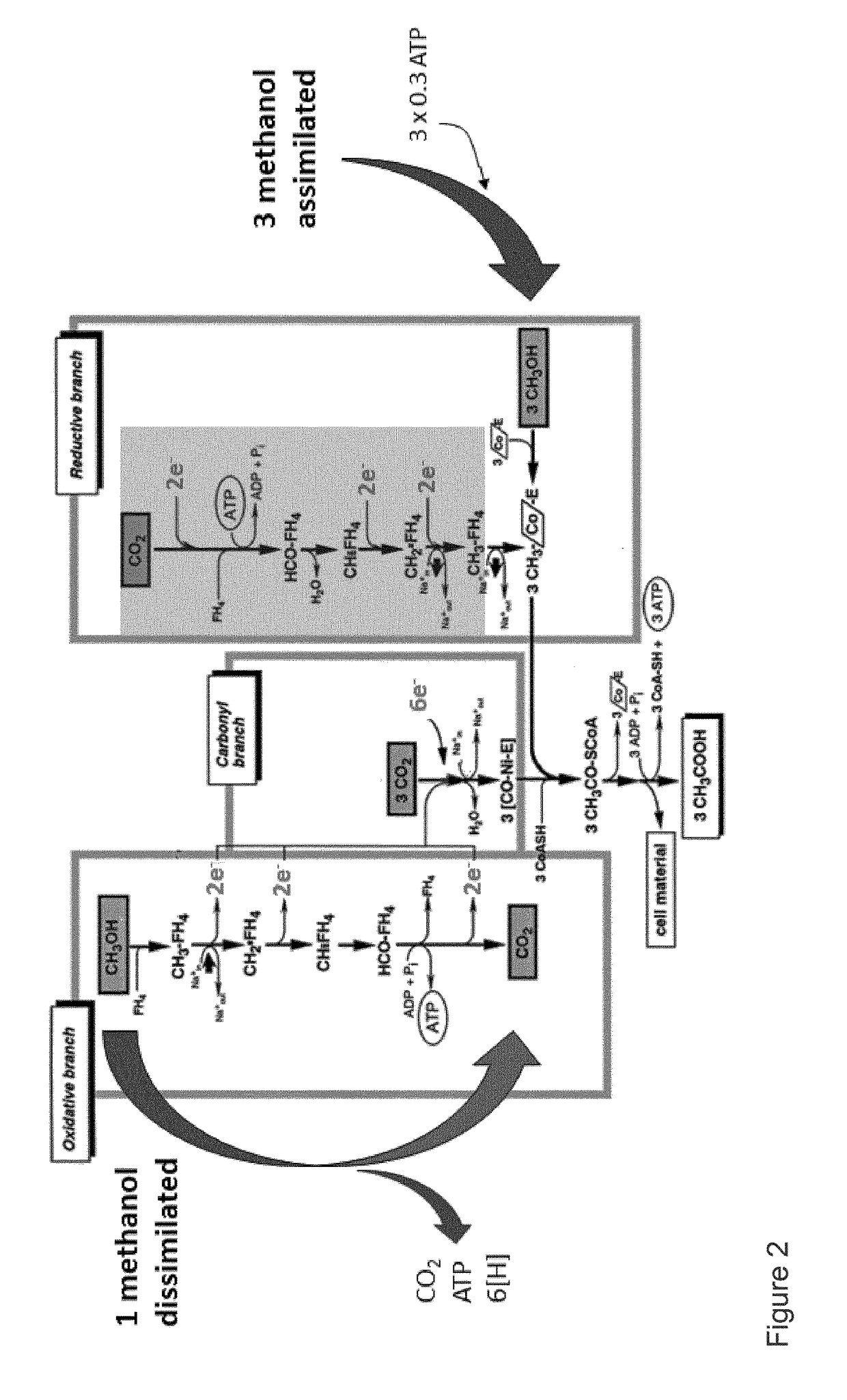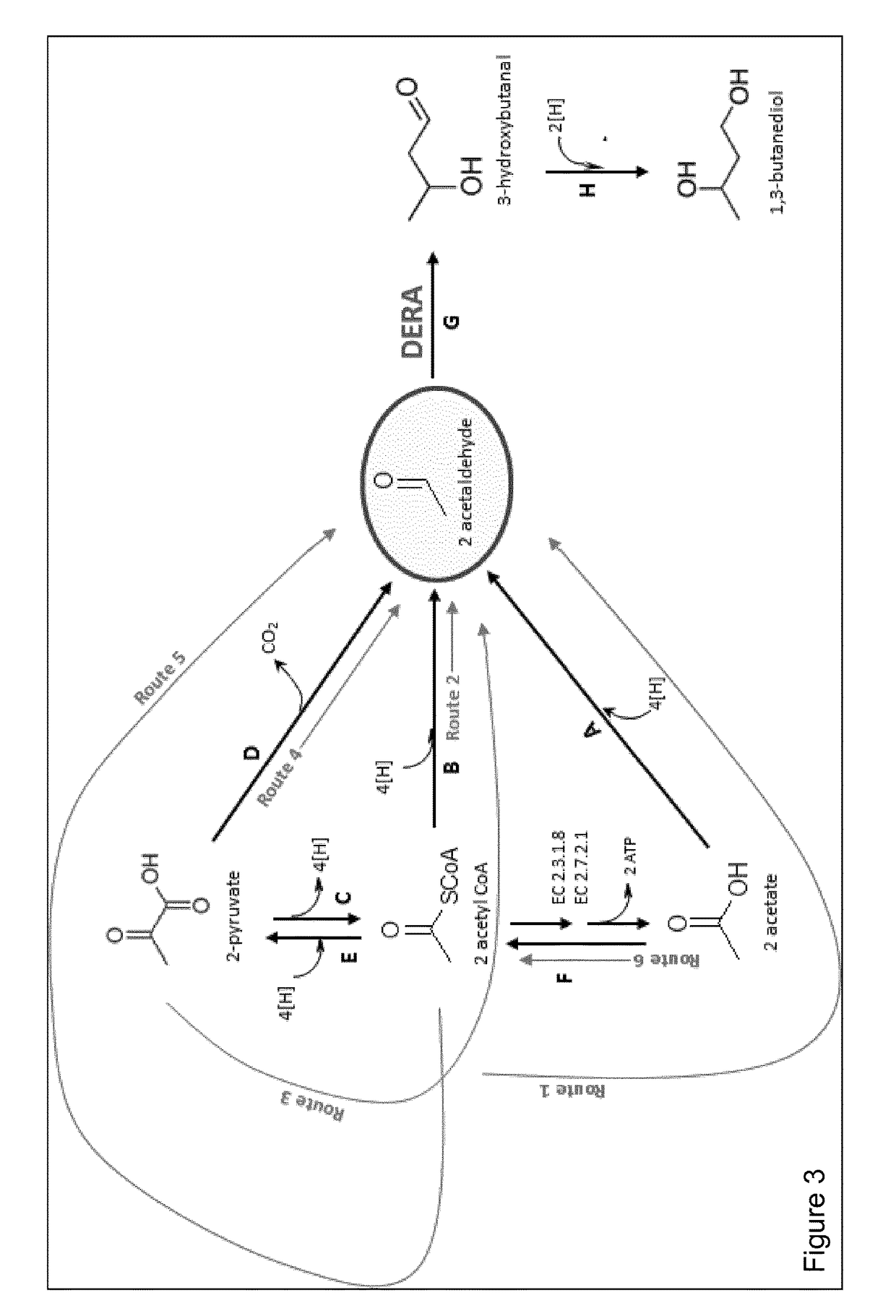Modified microorganisms and methods for production of useful products
a technology of microorganisms and products, applied in the field of microorganisms, can solve the problems of rising prices and significant lower quantities of c4 chemicals, and achieve the effects of preventing the loss of pyruvate, reducing the accumulation of acetate, and enhancing the level of acetyl coa
- Summary
- Abstract
- Description
- Claims
- Application Information
AI Technical Summary
Benefits of technology
Problems solved by technology
Method used
Image
Examples
example 1
r Acetaldehyde and 1,3-BDO Synthesis from Central Metabolites
[0235]The overall conversion of acetyl CoA to 1,3-butanediol is accomplished in either 3 or 5 steps depending on the route taken (FIG. 3) and in 1 or 3 steps to the common pathway intermediate acetaldehyde. Other products obtainable via acetaldehyde and 3-hydroxybutanal are described above (see also FIG. 17).
[0236]The overall conversion of pyruvate to 1,3-butanediol is accomplished in 3 or 4 steps depending on the route taken (FIG. 3) and in 1 or 2 steps to the common pathway intermediate acetaldehyde.
[0237]The two steps from acetaldehyde to 1,3-butanediol are common to all 1,3,-butanediol synthetic routes.
[0238]The description of the pathways is provided as routes for acetaldehyde synthesis (Route 1,2, 3, 4, 5 and 6) and the subsequent conversion of acetaldehyde to 1,3-butanediol via the aldol condensation catalysed by DERA.
Route 1—Conversion of Acetyl CoA to Acetaldehyde Via Acetate
[0239]Acetogens naturally produce aceta...
example 2
n of Acetaldehyde to 3-Hydroxybutanal
[0265]The syntheses described herein via the intermediate compound 3-hydroxybutanal. Synthesis of 3-hydroxybutanal is achieved using an enzyme capable of the aldol condensation of two molecules of acetaldehyde. This reaction is catalysed by deoxyribose phosphate aldolase (DERA, EC 4.1.2.4). This aldolase can be sourced from a wide range of microorganisms with the example from E. coli having been studied in detail for the synthesis of statin intermediates.
[0266]The NIH Genbank® database of publicly available nucleotide sequences (http: / / www.ncbi.nlm.nih.gov / gene) may be used to identify genes encoding proteins classified as EC 4.1.2.4. Bacterial genes annotated with EC 4.1.2.4 number 1137 as of 6 Jul. 2014; by phylum, there are 394 examples in the firmicutes, 387 in proteobacteria, 153 in actinobacteria, 50 in cyanobacteria and 153 in others. There are also 52 archaeal genes annotated with EC 4.1.2.4. These data are summarised in Table 6.
TABLE 6Di...
example 3
of 3-Hydroxybutanal to 1,3-Butanediol
[0268]Genes coding for enzymes capable of the reduction of an aldehyde to the corresponding alcohol (EC 1.1.1.-) are widespread in nature and with respect to this application are generally classified in EC 1.1.1.78; 1.1.1.265; 1.1.1.373; 1.1.1.1; 1.1.1.2; 1.1.1.21; 1.1.1.26; 1.1.1.31; 1.1.1.71; 1.1.1.72; 1.1.1.77 and 1.1.1.283 For this application it is desirable that aldehyde reductase or alcohol dehydrogenases enzymes (both terms refer to enzymes capable of aldehyde reduction) show preference towards a C4 aldehyde relative to a C2 aldehyde such as acetaldehyde. Alcohol dehydrogenases involved in ethanol synthesis for example, preferring acetaldehyde as a substrate would not be preferred for this application, but evolution of these well described short chain dehydrogenase or reductases using techniques well known in the art, could be used to alter the substrate preference towards longer chain aldehydes.
[0269]This reaction can be catalysed by a m...
PUM
| Property | Measurement | Unit |
|---|---|---|
| enzyme activity | aaaaa | aaaaa |
| carboxylic acid reductase activity | aaaaa | aaaaa |
| of time | aaaaa | aaaaa |
Abstract
Description
Claims
Application Information
 Login to View More
Login to View More - R&D
- Intellectual Property
- Life Sciences
- Materials
- Tech Scout
- Unparalleled Data Quality
- Higher Quality Content
- 60% Fewer Hallucinations
Browse by: Latest US Patents, China's latest patents, Technical Efficacy Thesaurus, Application Domain, Technology Topic, Popular Technical Reports.
© 2025 PatSnap. All rights reserved.Legal|Privacy policy|Modern Slavery Act Transparency Statement|Sitemap|About US| Contact US: help@patsnap.com



